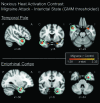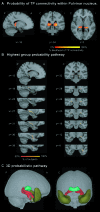Painful heat reveals hyperexcitability of the temporal pole in interictal and ictal migraine States
- PMID: 20562317
- PMCID: PMC3020583
- DOI: 10.1093/cercor/bhq109
Painful heat reveals hyperexcitability of the temporal pole in interictal and ictal migraine States
Abstract
During migraine attacks, alterations in sensation accompanying headache may manifest as allodynia and enhanced sensitivity to light, sound, and odors. Our objective was to identify physiological changes in cortical regions in migraine patients using painful heat and functional magnetic resonance imaging (fMRI) and the structural basis for such changes using diffusion tensor imaging (DTI). In 11 interictal patients, painful heat threshold + 1°C was applied unilaterally to the forehead during fMRI scanning. Significantly greater activation was identified in the medial temporal lobe in patients relative to healthy subjects, specifically in the anterior temporal pole (TP). In patients, TP showed significantly increased functional connectivity in several brain regions relative to controls, suggesting that TP hyperexcitability may contribute to functional abnormalities in migraine. In 9 healthy subjects, DTI identified white matter connectivity between TP and pulvinar nucleus, which has been related to migraine. In 8 patients, fMRI activation in TP with painful heat was exacerbated during migraine, suggesting that repeated migraines may sensitize TP. This article investigates a nonclassical role of TP in migraineurs. Observed temporal lobe abnormalities may provide a basis for many of the perceptual changes in migraineurs and may serve as a potential interictal biomarker for drug efficacy.
Figures





References
-
- Afra J, Mascia A, Gerard P, Maertens de Noordhout A, Schoenen J. Interictal cortical excitability in migraine: a study using transcranial magnetic stimulation of motor and visual cortices. Ann Neurol. 1998;44:209–215. - PubMed
-
- Afra J, Proietti Cecchini A, Sandor PS, Schoenen J. Comparison of visual and auditory evoked cortical potentials in migraine patients between attacks. Clin Neurophysiol. 2000;111:1124–1129. - PubMed
-
- Afridi SK, Giffin NJ, Kaube H, Friston KJ, Ward NS, Frackowiak RS, Goadsby PJ. A positron emission tomographic study in spontaneous migraine. Arch Neurol. 2005;62:1270–1275. - PubMed
-
- Afridi SK, Matharu MS, Lee L, Kaube H, Friston KJ, Frackowiak RS, Goadsby PJ. A PET study exploring the laterality of brainstem activation in migraine using glyceryl trinitrate. Brain. 2005;128:932–939. - PubMed
-
- Ambrosini A, Rossi P, De Pasqua V, Pierelli F, Schoenen J. Lack of habituation causes high intensity dependence of auditory evoked cortical potentials in migraine. Brain. 2003;126:2009–2015. - PubMed
Publication types
MeSH terms
Substances
Grants and funding
LinkOut - more resources
Full Text Sources
Medical

